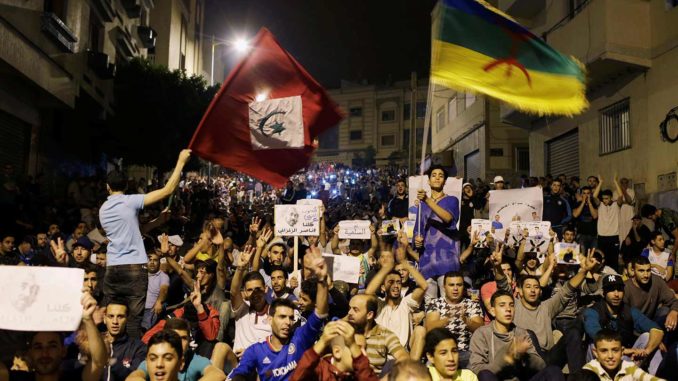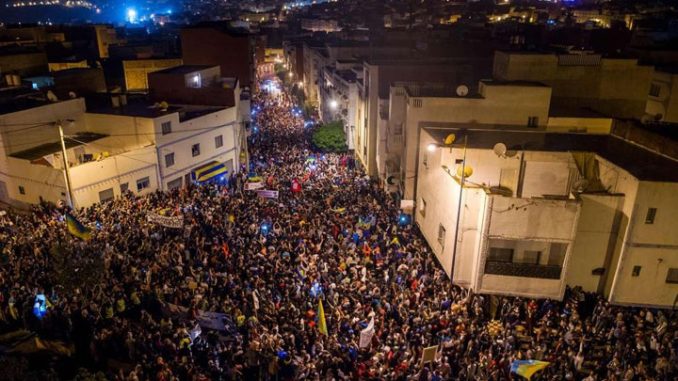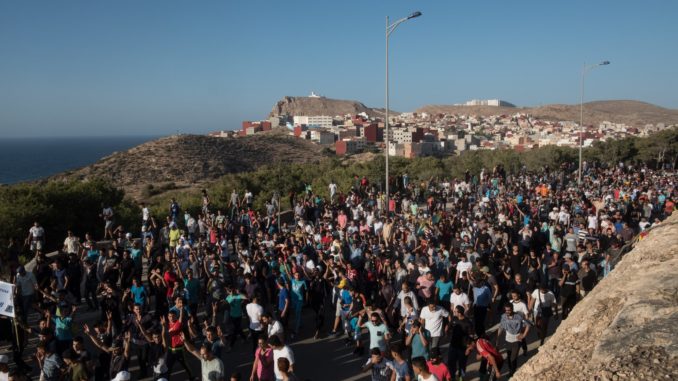
Rabat, MOROCCO – On October 28, 2016, Mohsine Fikri, a 31-year-old fish seller, was crushed in a garbage truck while trying to retrieve the merchandise that had been confiscated from him by authorities. The tragedy took place in the city of El Hoceima, in the Rif region in northern Morocco. Fikri’s horrendous death shocked the Moroccan public and prompted protests in more than twenty cities, raising fears among political leaders of a reawakening of the pro-democracy protest movement which shook the country in 2011, in the wake of the Tunisian and Egyptians revolutions.
Protesters first asked for an independent investigation into the circumstances of Fikri’s death, but their demands quickly evolved into a movement calling for an end to corruption and for the development of a region whose inhabitants have long felt marginalized by the Moroccan state. In the Rif region, the unemployment rate is over 20 percent of the labor force, twice the national average, while the informal economy prevails. Most households rely on the financial support of family members living in Europe, mainly in the Netherlands and Belgium.
A year on, the demands of the Hirak (the movement) – including jobs, better infrastructure, access to healthcare and education, and the demilitarization of the region – are still very well alive. But the Hirak as a street force has vanished. No major protest has taken place in the region since July 20, when police forces violently dispersed and used tear gas against the inhabitants of El Hoceima and its surroundings as they tried to gather in the city.
According to university professor and political analyst Mohamed Chtatou, the movement has now taken the same path of the February 20 Movement, named after the first day of protests in February 2011. “It is in [a period of] lethargy but the flame is still here. Of course, it has been decapitated but the demands remain,” he said.
The Moroccan Association of Human Rights (AMDH) has voiced its concern over the arrest of more than 400 people in connection with the Hirak since last May, when an unprecedented crackdown initiated. Among them were eight journalists – seven are still detained – who covered the protests for local news websites and were prosecuted under the criminal code instead of Morocco’s new press law, which does not include imprisonment sentences.
Through a mix of financial concessions and heavy repression, authorities have succeeded in silencing the Hirak. The press also played a major role in discrediting the movement’s leaders, spreading unfounded rumors and accusing activists of being separatists, of creating fitna – division and disorder in the community, a serious accusation in Morocco. In recent months, the Hirak has transformed into a movement mainly calling for the release of political prisoners.
In Morocco, the history of protest movements is one of perpetual renewal. The February 20 Movement, which called for more democracy, accountability from political leaders, and an end to widespread corruption, led the biggest protests the country had witnessed in its recent history. While protests took place in as much as 115 cities at the peak of the mobilization in April 2011, activists were soon arrested and by 2013, the focus had become the release of detainees.
Last May, the jailing of the Hirak leaders dealt a first blow to the movement, which had been going on since October but remained contained to the Rif region. Nasser Zefzafi, presented as its main leader, is still detained and under trial while Sylia Ziani, a singer, arrested in June and held at the Oukacha prison in Casablanca for almost two months, was granted a royal pardon with about 40 other protesters. On November 30th, Mortada Iamrachen, a well-known Hirak activist and a Salafist known for his openness, has been sentenced to five years of jail time, officially for inciting terrorism in a Facebook post.
Their arrests quickly resonated throughout the country, prompting demonstrations, at times repressed, in major cities like Rabat, Khouribga, Casablanca, Fès, Meknès, Agadir, Marrakech. On June 11 of this year, 50,000 people, including members of the Islamist organization Al Adl Wal Ihsane as well as leftists and human rights activists, gathered in Rabat, Morocco’s capital, with the family members of the Hirak prisoners. This was the biggest protest since 2011.
Although the issue of the Hirak’s prisoners remains unsolved, and dozens have been sentenced to jail sentences, the situation has more or less gone back to normal in the streets of El Hoceima. And while protesters and activists still take to the streets in solidarity sit-ins in other cities, their outreach is mainly symbolic. However, demonstrators manage to gather in the city of Imzouren, next to El Hoceima, once a major stronghold of the Hirak.

Until now, the government’s actions have mainly consisted of financial concessions and the sacking of four ministers accused of being responsible for delays in the development project called “El Hoceima Manarat Al Moutawassit” (El Hoceima, Beacon of the Mediterranean). This project includes the construction of hospitals, roads, cultural and sport centers, and equipment for the treatment of cancer, a major demand as the inhabitants of the region are more likely to get cancer because of the bombings that took place there in the early twentieth century. The development project was launched two years ago and became the focus of the street protests in the Rif. As a response, King Mohamed VI directly intervened on the issue and ordered an investigation into the slow pace of the region’s development.
Morocco’s main political actors have dramatically changed their discourse in response to the Hirak. Moroccan Prime Minister Saadeddine El Othmani even recognized that the press and government’s accusations that Hirak leaders were separatists was a mistake. The demands of the Hirak are not vilified by the central government anymore. Rather, they have been progressively accepted as legitimate social and economic grievances and even at times defended; Each time a protest movement arises, the government reacts with both repression and a response to part of the demands.
“The government does things. We have to admit it. There is action. In the Rif but also in other regions, there are investments being made,” said Professor Chtatou. While observers recognize government efforts to improve the economic and social problems the region is facing, they also warn of a major democratic setback. Amnesty International recently denounced widespread human rights violations in Morocco, and even reported torture of Hirak detainees.
Recently, 54 people considered political prisoners by Hirak activists and human rights defenders were presented in court. The prisoners include Nasser Zefzafi, whose trial started on July 10, and journalist Hamid Mahdaoui, editor of the website Badil Info (the website has been shut down), who openly supported the movement. Mahdaoui has already been sentenced to a year in prison for “incitement to protest” and is now accused of “failure to denounce a crime threatening national security.” He faces a five-year sentence, according to Reporters Without Borders.

The Rif region already paid a heavy price when dozens of young people were arrested for taking part in the February 20 protests. A few activists who were sentenced for taking part in the February 20 movement have completed their jail time and have since been sent back to jail for continued participation in the Hirak.
In addition, human rights activists continue to demand an investigation into a tragedy that has fueled resentment in the region: the death of five young people whose burnt bodies were found in a bank in El Hoceima in the first day of protests in 2011. The Moroccan Association of Human Rights (AMDH) and Hirak activists are still demanding an independent investigation into the death of the five victims. The impunity and lack of action on the part of the state has added further fuel to the fire of the Hirak protests.
“In the Rif, there is a continuous dynamic of social movements,” explained Ahmed (his name has been changed to protect his identity), a February 20 and Hirak activist from El Hoceima. “When there were February 20 Movement protests, we participated. There is a continuity, the mechanisms and the slogans are similar with the Hirak. But there are also young people, new activists, who didn’t take part in the February 20 Movement and have joined the Hirak.”
Since October 2016, the Rif’s calls have echoed throughout the country, in towns and cities facing similar social and economic difficulties. In recent months, marches and sit-ins have taken place in diverse regions. In the center in Beni Mellal, in the south in Zagora, and in Tinghir, Imintanout and Imider, the inhabitants have relentlessly asked for better infrastructures, health facilities, and access to clean water.
“Those people have taken to the streets because of the Hirak. They have taken advantage of that atmosphere to express their own social demands,” explained Adbellah Lefnatsa, an activist at the AMDH and member of the Marxist-Leninist party Annahj Addimocrati (The Democratic Way). “The demands are old but the movements and the way they claim and express them are new. These are ancient causes: the social deficit, the disparities between rich and poor. They are the result of an uneven distribution of wealth and this is worsening. We can feel a social explosion but that does not necessarily mean change. For now, the system settles it with a carrot and stick policy.”
Ilhem Rachidi is a freelance reporter based in Morocco. Rachidi has written extensively on protest movements and human rights issues, publishing articles in the French newspaper Mediapart (where she has worked as a correspondent for four years), Rue89, Al Monitor, and The Christian Science Monitor.
